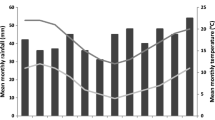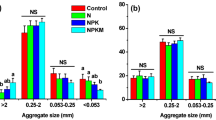Abstract
The mechanisms resulting in the binding of primary soil particles into stable aggregates vary with soil parent material, climate, vegetation, and management practices. In this study, we investigated short-term effects of: (i) nutrient addition (Hoagland's solution), (ii) organic carbon (OC) input (wheat residue), (iii) drying and wetting action, and (iv) root growth, with or without dry–wet cycles, on aggregate formation and stabilization in three soils differing in weathering status and clay mineralogy. These soils included a young, slightly weathered temperate soil dominated by 2:1 (illite and chlorite) clay minerals; a moderately weathered soil with mixed [2:1 (vermiculite) and 1:1 (kaolinite)] clay mineralogy and oxides; and a highly weathered tropical soil dominated by 1:1 (kaolinite) clay minerals and oxides. Air-dried soil was dry sieved through a 250 μm sieve to break up all macroaggregates and 100 g-subsamples were brought to field capacity and incubated for 42 days. After 14 and 42 days, aggregate stability was measured on field moist and air-dried soil, to determine unstable and stable aggregation respectively. In control treatments (i.e., without nutrient or organic matter addition, without roots and at constant moisture), the formation of unstable and stable macroaggregates (> 250 μm) increased in the order: 2:1 clay soil < mixed clay soil < 1:1 clay soil. After 42 days of incubation, nutrient addition significantly increased both unstable and stable macroaggregates in the 2:1 and 1:1 clay soils. In all soils, additional OC input increased both unstable and stable macroaggregate formation. The increase in macroaggregation with OC input was highest for the mixed clay soil and lowest for the 1:1 clay soil. In general, drying and wetting cycles had a positive effect on the formation of macroaggregates. Root growth caused a decrease in unstable macroaggregates in all soils. Larger amounts of macroaggregates were found in the mixed clay and oxides soil when plants were grown under 50% compared to 100% field capacity conditions. We concluded that soils dominated by variable charge clay minerals (1:1 clays and oxides) have higher potential to form stable aggregates when OC concentrations are low. With additional OC inputs, the greatest response in stable macroaggregate formation occurred in soils with mixed mineralogy, which is probably a result of different binding mechanisms occurring: i.e., electrostatic bindings between 2:1 clays, 1:1 clays and oxides (i.e. mineral-mineral bindings), in addition to OM functioning as a binding agent between 2:1 and 1:1 clays.
Similar content being viewed by others
References
Alexiades C A and Jackson M L 1965 Quantitative determination of vermiculite in soils. Soil Sci. Soc. Am. Proc. 29, 522-527.
Blakemore L C, Searle R L and Daly B K 1987 Methods for chemical analysis of soils. N.Z. Soil Bureau of Sci. Rep. 80. New Zealand Soil Bureau, Lower Hutt.
Caron J, Kay B D and Stone J A 1992 Improvement of structural stability of a clay loam with drying. Soil Sci. Soc. Am. J. 56, 1583-1590.
Czarnes S, Hallett P D, Bengough A G and Young I M 2000 Root-and microbial-derived mucilages affect soil structure and water transport. Eur. J. Soil Sci. 51, 435-443.
Degens B P 1997 Macroaggregation of soils by biological bonding and binding mechanisms and the factors affecting these: a review. Aust. J. Soil Res. 35, 431-459.
Denef K, Six J, Bossuyt H, Frey S D, Elliott E T, Merckx R and Paustian K 2001 Influence of dry-wet cycles on the interrelationship between aggregate, particulate organic matter, andmicrobial community dynamics. Soil Biol. Biochem. 33, 1599-1611.
Edwards A P and Bremner J M 1967 Microaggregates in soils. J. Soil Sci. 18, 64-73.
Elliott E T 1986 Aggregate structure and carbon, nitrogen, and phosphorus in native and cultivated soils. Soil Sci. Soc. Am. J. 50, 627-633.
Elliott E T, Palm C A, Reuss D E, Monz C A 1991 Organic matter contained in soil aggregates from a tropical chronosequence: correction for sand and light fraction. Agric. Ecosys. Environ. 34, 443-451.
El-Swaify S A 1980 Physical and mechanical properties of oxisols. In Soils with Variable Charge. Ed. B K G Theng. pp. 303-324. Offset Publications, Plamerston North, New Zealand.
Franzluebbers A J and Arshad M A 1996 Water-stable aggregation and organic matter in four soils under conventional and zero tillage. Can. J. Soil Sci. 76, 387-393.
Frye W W and Blevins R L 1997 Soil organic matter under long-term no-tillage and conventional tillage corn production in Kentucky. In Soil Organic Matter in Temperate Agroecosystems: Long-term Experiments in North America. Ed. E A Paul et al. pp. 343-351. CRC Press, Boca Raton, FL.
Gale W J, Cambardella C A and Bailey T B 2000 Root-derived carbon and the formation and stabilization of aggregates. Soil Sci. Soc. Am. J. 64, 201-207.
Hassink J 1997 The capacity of soils to physically protect organic C and N. Plant Soil 191, 77-87.
Haynes R J and Swift R S 1990 Stability of soil aggregates in relation to organic constituents and soil water content. J. Soil Sci. 41, 73-83.
Jager G and Bruins E H 1975 Effect of repeated drying at different temperatures on soil organic matter decomposition and characteristics, and on the soil microflora. Soil Biol. Biochem. 7, 153-159.
Jastrow J D 1996 Soil aggregate formation and the accrual of particulate and mineral-associated organic matter. Soil Biol. Biochem. 28, 665-676.
Jastrow J D, Miller R M and Lussenhop J 1998. Contributions of interacting biological mechanisms to soil aggregate stabilization in restored prairie. Soil Biol. Biochem. 30, 905-916.
Kemper W D and Koch E J 1966. Aggregate stability of soils from western United States and Canada pp. 1-52. Colorado Agricultural Experimental Station. Bulletin 1355.
Kemper W D and Rosenau R C 1984 Soil cohesion as affected by time and water content. Soil Sci. Soc. Am. J. 48, 1001-1006.
Kemper W D, Rosenau R C and Dexter A R 1987 Cohesion development in disrupted soils as affected by clay and organic matter and temperature. Soil Sci. Soc. Am. J. 51, 860-867.
Merckx R, Den Hartog A and Van Veen J A 1985 Turnover of rootderived material and related microbial biomass formation in soils of different texture. Soil Biol. Biochem. 17, 565-569. Lynch J M and Bragg E 1985 Microorganisms and soil aggregate stability. Adv. Soil Sci. 2, 134-170.
Lyon D J, Monz C A, Brown R E and Metherell A K 1997 Soil organic matter changes over two decades of winter wheatfallow cropping in Western Nebraska. In Soil Organic Matter in Temperate Agroecosystems: Long-term Experiments in North America. Ed. E A Paul et al. pp. 343-351. CRC Press, Boca Raton, FL.
Materechera S A, Kirby J M, Alston A M and Dexter A R 1994 Modification of soil aggregation by watering regime and roots growing through beds of large aggregates. Plant Soil 160, 57-66.
Miller R M and Jastrow J 1990 Hierarchy of root and mycorrhizal fungal interactions with soil aggregation. Soil Biol. Biochem. 22, 579-584.
Moore D M and Reynolds R C 1997 X-ray Diffraction and the Identification and Analysis of Clay Minerals. 2nd edn. Oxford Univ. Press, Oxford, UK.
Oades J M and Waters A G, 1991 Aggregate hierarchy in soils. Aust. J. Soil Res. 29, 815-828.
Parks G A 1965 The isoelectric points of solid oxides, solid hydroxides, and aqueous hydroxo complex systems. Chem. Rev. 65, 177-198.
Perfect E, Kay B D, van Loon W K P, Sheard R W and Pojasok T 1990 Factors influencing soil structural stability within a growing season. Soil Sci. Soc. Am. J. 54, 173-179.
Pinheiro-Dick D and Schwertmann U 1996 Microaggregates from oxisols and inceptisols: dispersion through selective dissolutions and physicochemical treatments. Geoderma 74, 49-63.
Pleysier J L and Juo A S R 1980 A single-extraction method using silver-thiourea for measuring exchangeable cations and effective CEC in soils with variable charges. Soil Sci. 129, 205-211.
Puget P and Drinkwater L E 2001 Short-term dynamics of root-and shoot-derived carbon from a leguminous green manure. Soil Sci. Soc. Am. J. 65 (2001) 771-779.
Puget P, Chenu C and Balesdent J 1995 Total and young organic matter distributions in aggregates of silty cultivated soils. Eur. J. Soil Sci. 46, 449-459.
Reid J B and Goss M J 1981 Effect of living roots of different plant species on the aggregate stability of two arable soils. J. Soil Sci. 32, 521-541.
Reid J B, Goss M J and Robertson P D 1982 Relationship between the decreases in soil stability affected by the growth of maize roots and changes in organically bound iron and aluminum. J. Soil Sci. 33, 397-410.
Reyes I and Torrent J 1998 Citrate-Ascorbate as a highly selective extractant of poorly crystalline iron oxides. Soil Sci. Soc. Am. J. 61, 1647-1654.
Santos H P dos, Ignaczak J C and Lhamby J C B 1995 Produtividade cultural de sistemas de rotacao para trigo durante dez anos, em Passo Fundo, RS. Pesq. Agropec. Bras., Brasilia 30 (12), 1397-1402.
SAS Institute, 1990. SAS STAT user's guide. Vol. 2. Version 6 ed. SAS inst., Cary, NC.
Schahabi S and Schwertmann U 1970 Der einfluss von synthetischen eisenoxides auf die aggregation zweier lussbodenhorizonte. Z. Pflanzenernahr. Bodenk. 125, 193-204.
Schofield R K and Samson H R 1954 Flocculation of kaolinite due to the attraction of oppositely charged crystal faces. Faraday Discussions 18, 659-673.
Six J, Elliott E T, Paustian K and Doran J W 1998 Aggregation and soil organic matter accumulation in cultivated and native grassland soils. Soil Sci. Soc. Am. J. 65, 1367-1377.
Six J, Elliott E T, Paustian K and Combrink C 2000a Soil structure and organic matter. I. Distribution of aggregate size classes and aggregate-associated carbon. Soil Sci. Soc. Am. J. 64, 681-689.
Six J, Elliott E T and Paustian K 2000b Soil structure and soil organic matter: II. A normalized stability index and effects of mineralogy. Soil Sci. Soc. Am. J. 64, 1042-1049.
Six J, Feller C, Denef K, Ogle S, de Moreaes Sa J C and Albrecht A Soil organic matter dynamics, biota and aggregation in temperate and tropical soils: effect of no-tillage. Agronomy: Agriculture and Environment. In press (MS 01.120 SP 05).
Soil Survey Laboratory Staff 1992 Soil survey laboratory methods manual. Soil Surv. Invest. Reps. 42, USDA-SCS, Washington, DC.
Sposito G 1989 The Chemistry of Soils. Oxford University Press, New York.
Tisdall J M and Oades J M 1979 Stabilization of soil aggregates by the root systems of ryegrass. Aust. J. Soil Res. 17, 429-441.
Tisdall J M and Oades J M 1982 Organic matter and water-stable aggregates in soils. J. Soil Sci. 33, 141-163.
Utomo W H and Dexter A R 1982 Changes in soil aggregate water stability induced by wetting and drying cycles in non-saturated soil. J. Soil Sci. 33, 623-637.
Wander M M and Yang X 2000 Influence of tillage on the dynamics of loose-and occluded particulate and humified organic matter fractions. Soil Biol. Biochem. 32, 1151-1160.
Author information
Authors and Affiliations
Corresponding author
Rights and permissions
About this article
Cite this article
Denef, K., Six, J., Merckx, R. et al. Short-term effects of biological and physical forces on aggregate formation in soils with different clay mineralogy. Plant and Soil 246, 185–200 (2002). https://doi.org/10.1023/A:1020668013524
Issue Date:
DOI: https://doi.org/10.1023/A:1020668013524




